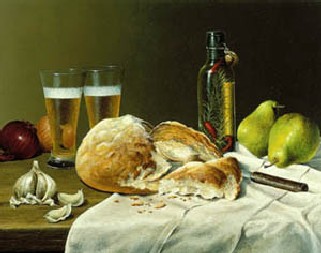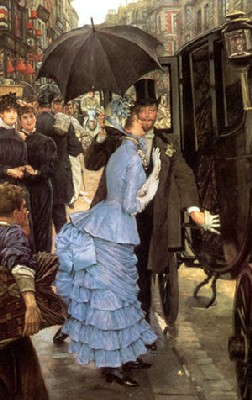 |
Manners, Customs, Clothing
Manners Make Life Easier
Marian T. Horvat, Ph.D.
“What’s the point of all those etiquette rules and fancy stuff? I bet some prissy old English dame or Frenchman with curls invented it all just to make the rest of us feel stupid.”
We have all heard such complaints about manners, that they are just mere conventions that stand in the way of the good American pioneer way of straightforward truth and plain living. That the rules of social etiquette are threats to self-expression and freedom. That they don’t really mean anything.
In fact, nothing could be further from the truth.
Manners and courtesies, customs and conventions were not developed with the notion of making life more difficult for men and women. They had a purpose that was the exact opposite: to make life more amenable in the necessary relationships of existence, and more bearable in the inevitable difficult times. At the very heart of good manners is something so lacking in our days, that is, consideration for others. Good manners came into being not artificially, but based on an authentic concern for the respect of others.
If today, consideration for others is so lacking and social relations so shattered, I think we can safely say one reason is because good manners and normal courtesy have been disregarded as unnecessary and superfluous. Far from being superfluous, most manners developed as a result of a shared ethics and moral code. Some small but illustrative examples follow.
Manners have meaning
Every etiquette book instructs us that one does not bite into a whole slice of bread or whole roll. The well-bred man or woman breaks off a small piece to eat. This rule of breaking bread into morsels was not made by persnickety Victorian ladies at afternoon tea. It goes back to Old Testament times when it was the custom for table leavings to be collected after the meal and given to the poor. In consideration for those who would receive the leftovers, one broke off only what piece he would eat from the bread. Thus the expression, breaking bread together.

Charity summoned into being the table rule of breaking off only the piece of bread one will eat |
The charitable practice was continued in the monasteries of early medieval times and from there, found its way into grand castles and simple households. A 15th-century Book of Courtesy gave this explanation:
Bite not thy bread and lay it down,
This is not courtesy to use in town;
But break as much as you will eat
The remnant to the poor you shall lete [leave].
What summoned the rule into being was charity, a courtesy to those who would take and use the bread that remained after the meal was over. Leftovers, yes, but untouched by the lips of others. And such courtesy still justifies the existence of such rule today.
The salt and pepper should always travel together, the books of etiquette instruct. When someone asks for salt, one should pass the pepper as well. An arbitrary rule? Not at all. The rationale behind the rule is again one of consideration, an anticipation that the person requesting salt may have an eventual need for the pepper. It is also a consideration for the next person at the table who may need the salt and pepper, who will not have to chase them down at different places. Following the rules, we show consideration for others and make life easier and more pleasant for all.
A constant and unchanging dictate of good manners is to never criticize the food on the table. This rule used to be taught even to young children, who were chastised should they cry out: “Yuck! This is horrible.” “Sickening.” The more vulgar commentary that can be heard at tables so often today does not bear repeating, even for example’s sake.
Obviously, to criticize a meal offered shows a lack of consideration for the one who prepared or provided it. It is a self-centered reaction of one who imagines his own likes and dislikes the central criterion of all. But the rule has a more interesting history. Again, it came from the ancients and medievals, who viewed any criticism of food served at the table of the host as a grave breach against hospitality. Having once been invited to share the meal in a house, an invitation which used to be taken very seriously, the guest would never diminish the host by criticizing the food.
What was probably the first book dealing with table etiquette, Fifty Courtesies of the Table, written by a Milanese monk Bonvicino da Riva, sets down the rule very plainly:
“Blame not the dishes when thou art at entertainment, but say that all are good. I have detected many ere while in this vile habit, saying ‘This is ill cooked,’ or ‘This is ill salted.’
Other courtesies of the table the book warns again would seem elementary in any times but our own: not to wipe your nose while eating, not to scratch yourself while eating, not to gulp food and liquid in one mouthful, not to lick one’s fingers clean of food or pick one’s teeth with the fingers, not to stare in others’ plates, not to talk with a mouthful of food, and certainly never to belch loudly in the presence of others.

Helping the lady into the carriage, a gentile courtesy that signaled the man's protection and respect for ladies |
The good monk’s rules are presented in that straightforward style Americans like. Demanding self-restraint in consideration for others, these laws for behavior at the table are timeless and changeless. The message at the heart of all the directives is simple: A courteous man, a man of refinement, a Catholic gentleman or lady should consider others at all times, and especially while dining.
Another sound rule of the past sadly disregarded at present is to rise to one’s feet when a lady, an older person or a dignitary enters a room. This was a sign of respect for age and rank. A simple gesture like this helped to instill in youth a respect for age, rank, and authority. And far from diminishing freedom, knowing the right way to behave according to one’s age and position gives security and self-confidence to all.
In the pre-liberated woman days, gentleman were always taught to walk on the “outside” of a lady, giving her the “wall” side in the street, to provide her protection from the dirt of the road or runaway horses. But, whatever the reason, the good rationale behind the custom was that the lady received this deferential position because she was a lady and worthy of protection. For the same reason, the gentleman used to help the lady to enter the carriage, and later, he opened the car door to seat the lady. Such gentile courtesies were symbols of the authority of the man, the protection he offered, and the mutual respect that existed in a relationship.
Manners reflect the morals of a civilization
If there were time, we could subject every manner to the test of good sense and reason. No custom or gesture would be random, or superfluous. For the laws of courtesy were the development of the spiritual as well as social man, reflecting the wisdom of the Catholic faith that was instilled in the customs, traditions and mores.
There is much talk today about the hostility, alienation, and vulgarity of the modern man. It seems to me a realistic way to begin to tackle the problem – in that old-fashioned straightforward way of Americans – would be a return to the practice of the forms and courtesies developed through centuries of Catholic living. For, as one can see from the few examples above, manners have profound meaning and make life easier and more bearable.

Posted June 15, 2004

Related Works of Interest
|
Manners | Cultural | Home | Books | CDs | Search | Contact Us | Donate

© 2002- Tradition in Action, Inc. All Rights Reserved
|
 |

|